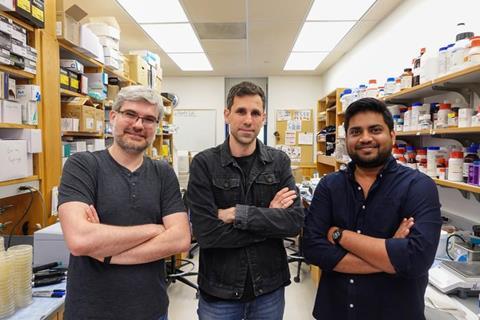Since the discovery of penicillin nearly a century ago, antimicrobial resistance (AMR) has become a stealthy, pervasive enemy in the fight against bacterial infections. AMR claims an estimated 1.27 million lives a year and contributed to nearly five million deaths in 2019, placing drug-resistant bacterial infections ahead of HIV and malaria as a global health threat.

To counter that trend, a cross-disciplinary team representing four schools at the University of Pennsylvania led by Hydar Ali and César de la Fuente has devised a new way to treat infections. Their findings, published in Cell Biomaterials, identified a handful of short, positively charged peptides that can both rip open bacterial membranes and rally the body’s immune defenses.
READ MORE: Barriers remain to peptide-based therapies - but there are answers, reveals study
READ MORE: Peptide cocktails could be key to fighting antibiotic resistance
“The winning candidates are built from D-amino acids, the mirror images of the L-amino acids our bodies use,” says de la Fuente, a Presidential Associate Professor in the Perelman School of Medicine. “That simple flip makes the peptides almost invisible to the body’s digestive enzymes, so they stay intact and effective far longer than earlier peptide drugs.”
Protective membranes
In laboratory dishes, the lead peptides pierced the protective membranes of the particularly stubborn group of pathogens known as the ESKAPEEs (Enterococcus faecium, Staphylococcus aureus, Klebsiella pneumoniae, Acinetobacter baumannii, Pseudomonas aeruginosa, Enterobacter species and Escherichia coli). It also latched onto mast cells—immune sentinels best known from allergy attacks—prompting them to release inflammatory signals such as TNF-α, IL-8 and CCL3 that summon bacteria-eating white blood cells.
That one-two punch of breaking through bacterial walls and simultaneously activating mast-cell action hinges on a cellular-surface G-protein-coupled receptor called MRGPRX2. The receptor, which is most abundant on skin-resident mast cells—guarding against infections like Staph—acts a bit like a “panic button,” flipping “on” when the designer peptide docks in its binding pocket.
That signal then triggers calcium-driven degranulation, bringing histamine plus a mix of cytokines and chemokines that recruit neutrophils and monocytes to the infection site to swarm and engulf invading bacteria, and downstream clear debris and coordinate longer-term immune defenses.
Converting armies into allies
“By engaging MRGPRX2, the peptide turns the host’s immune army into an ally,” explains co-first author Marcelo der Torossian Torres, a research associate in de la Fuente’s Machine Biology Group. “It’s a knockout combo no conventional antibiotic can match.”
The dual action held up in living tissue: a single low-dose injection into MRSA-infected skin significantly reduced bacterial counts and sped healing. The benefit vanished in mice genetically lacking MRGPRX2, underscoring that immune activation is essential to the therapy’s success.
Because these mirror-image peptides both attack microbes directly and also stimulate the immune system for continued response, bacteria would need to overcome two distinct hurdles at once, which could potentially slow resistance. “With antibiotic resistance soaring worldwide, therapies that obliterate bacteria while turbocharging immunity mark a critical new frontier,” says co-first author Aetas Amponnawarat of the Ali Lab.
The researchers note that preclinical studies are underway to confirm the efficacy of the peptides in animal infection models and to refine dosing. They are also engineering derivative peptides aimed at other hard-to-treat pathogens and immune targets.







No comments yet